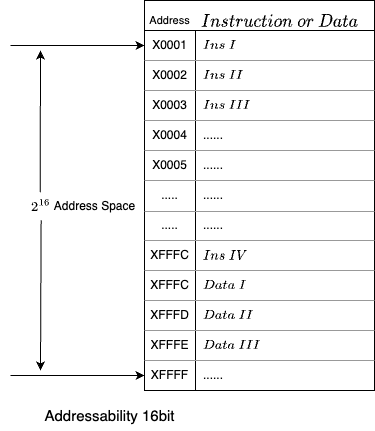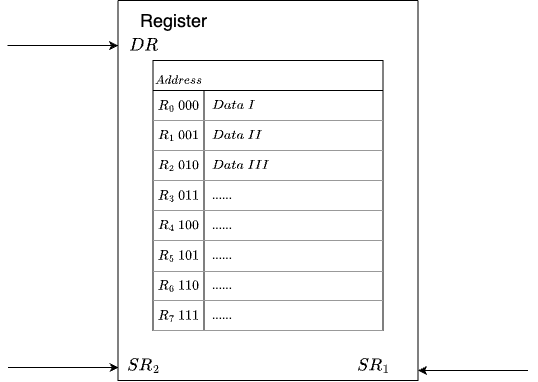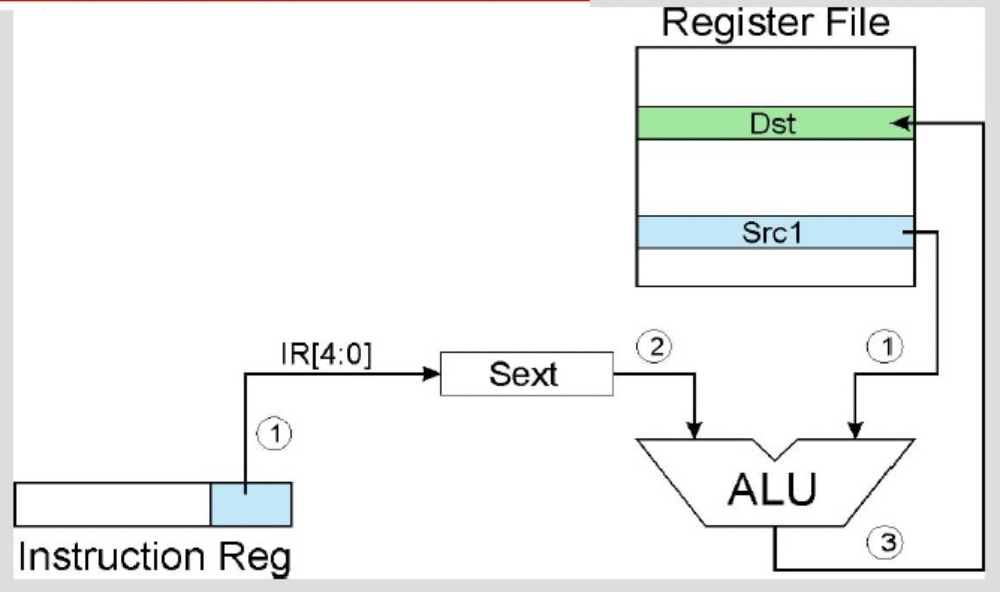ISA
- ISA specifies what hardware does, but not how
- ISA defines the instruction code
- Microarchitecture specifies how it does it
- Microarchitecture determine how it work it

The ISA specifies all the information about the computer that the software has to know.
- Memory
- Address space (how many locations?)
- Addressability (word or byte, word size)
- Registers
- Number (how many?)
- Type
- Instructions
- Operations
- Data types
- Addressing modes
Lc-3
- Lc-3 is a finite state machine

Lc-3 Memory Organization
- Address space
- means: there are
block
- means: there are
- Addressability
- Each block store 16-bit instruction
- Each block represent by a Hexadecimal code
- x0000
- x0001
- ....
- Address 逐行递增
- Each block represent by a Hexadecimal code
- Memory is store element
- Basic Operations
- LOAD
- read a value from a memory location
- STORE
- write a value to a memory location

- write a value to a memory location
- LOAD
Registers
features: Special storaqge devices that are inside the GPU. Fast to access 1 clock cycle General Purpose Register GPR: accessible instructions
Register is store element
- Achieved by D filp-flop
Register File
- 8 GPRs
- Each register represent by 3 bit to record its address
- 000
- 001
- 010
- ...
- 110
- 111
- 000
- Each register represent by 3 bit to record its address
- Source Register 1
- Source Register 2
- Destination Register
- 8 GPRs
Other special purpose registers:
- MAR,MDR
- PC,IR
- Condition codes: P,Z,N
- KBDR,KBSR,DDR,DSR

Instruction
- Opcode What the instruction does
- Operands What the operation acts on
In Lc-3
- 4 bits opcode (15)
- 2 Sources and 1 destination

Opcodes & Operations
Opcodes
Operate instructions Manipulate data directly
'Immediate' addressing mode
ADD 0001
AND 0101
---- --- --- --- ---
ADD DST SR1 000 SR2
0001 xxx xxx 000 xxx
---- --- --- --- ---
AND DST SR1 000 SR2
0001 xxx xxx 000 xxxWhen string bit is 0 the addressing mode is "register mode" Otherwise is "immediate mode"
---- --- --- - -----
ADD DST SR1 1 Imm5
0001 xxx xxx 1 Imm5
---- --- --- - -----
AND DST SR1 1 Imm5
0001 xxx xxx 1 Imm5Imm5 is a const integer and imm5 will be extend to 16 bits when it be calcuted.
- subtract
- 2's complement
- OR
- Set Zero
- AND 0000 0000 0000 0000

- NOT 1001 Register Addressing mode
---- --- --- -------
NOT DST SRC 111111
1001 Reg Reg 111111Data Movement instructions Move data between memory and registers(CPU)
Load read data from memory to register
- LD 0010 direct mode
- LDI 1010 base+offset mode
- LDR 0110 indirect mode
Store write data from register to memory
- ST 0011 direct mode
- STI 1011 base+offset mode
- STR 0111 indirect mode
Load effectively address compute address
- LEA 1110 immediate mode - does not access memory
---- --- ----------
LEA DR/SR addr.gen.bits
1110 DR/SR addr.gen.bits
Control instructions Change the sequence of instruction execution
- BR 0000
- JMP/RET 1100
- JSR/JSSR 0100
- RTI 0111
- TRAP 1111
Data Types
- 2's complement integers
Condition Codes
- 3 single bit registers (set to 1 or cleared to 0)
- N: when value written was negative
- Z: when value written was zero
- P: when value written was positive
- Affected each time any register is written
- Condition codes are read by conditional branch instructions
Addressing Modes
5 addressing modes
- Explicitly in the instruction itself 立即寻址
- In register 寄存器寻址
- In memory 内存寻址
- Pc-relative mode:
- Base+offset mode:
- Indirect mode: the address of a location that contains the address of the operand (indirect)
- Pc-relative mode:
PC-Relative Mode Direct mode 直接寻址
- LD
- opcode 0010
- effective address=(PC)+SEXT(IR[8:0])
---- --- ---------
LD Dst
0010 Reg
- ST
- Opcode 0011
- effective address=(PC)+SEXT(IR[8:0])
---- --- ----------
ST Dst
0011 Reg- offset 9 bits
operand must be within 256 locations of the instruction
Base+Offset Mode
- LDR
- opcode 0110
- effective address = (BaseRegister)+offset
---- --- --- ------
LDR Dst BaseR offset
0110 Reg Reg- offset 6 bits
Base+offset can address any location in memory 
- STR
- opcode 0111
- effective address = (BaseRegister)+offset
---- --- --- ------
STR Dst BaseR offset
0111 Reg RegIndirect Addressing Mode
An address is first formed exactly the same way as with LD and ST
This address contains the address of the operand.
Just like base+offset, indirect mode can also address any location in the memory.
Memory has to be accessed twice in order to get the address of the operand
LDI
- opcode 1010
- pointer address = (PC) + SEXT(IR[8:0])
- effective address = Mem[(PC)+SEXT(IR[8:0])]
---- --- ---------
LDI Dst Addr.Gen.bits
1010 Reg Addr.Gen.bits
- STI
- opcode 1011
- pointer address = (PC) + SEXT(IR[8:0])
- effective address = Mem[(PC)+SEXT(IR[8:0])]
Control Instructions
Lc-3 has 3 conditional code registers
- N negative
- Z zero
- P positive
set by any instruction that stores a value to a register
- ADD,AND,NOT,LD,LDR,LDI,LEA
BR
- opcode 0000
---- --- ---------
BR NZP offset
0000 NZP offsetwhen condition is satisfied PC=PC+offset 
- JMP jump OR goto
- opcode 1100
---- --- --- ------
JMP 000 BaseR 000000
1100 000 Reg 000000unconditional jump PC jump to Reg
- TRAP Invoke a system routine
- opcode 1111
---- ---- --------
TRAP 0000 trapvec
1111 0000PC is set to the instruction TRAP

